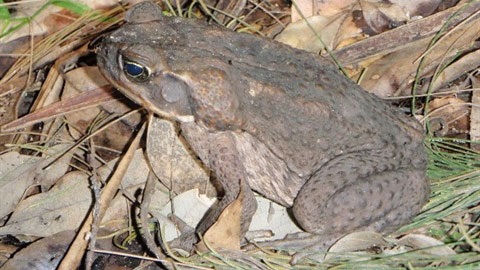Cane toads

An introduced species to Australia, cane toads are found throughout Moreton Bay. They are not listed as a prohibited or restricted invasive species under the Biosecurity Act 2014.
The weather in Moreton Bay creates the perfect breeding ground for cane toads. They breed in waterbodies including ponds, creeks, and dams following rainfall during the warmer months.
Some native wildlife such as crows, white ibis, and keelbacks (freshwater snakes) have adapted to become predators of cane toads.
Impacts of cane toads
Cane toads are toxic at all stages of life. They have glands behind their eyes that release poison. A toad's poison kills any animal that consumes them, including birds and reptiles who mistake them for frogs.
Domestic cats and dogs are also vulnerable to cane toads. Thousands of cane toad poisoning cases in cats and dogs occur annually in Australia.
They have huge appetites and eat anything they can fit in their mouths. This reduces populations of native insects, frogs, reptiles, and other small creatures. In urban areas, pet food can be a favourite food source.
How you can help manage cane toads
There are steps you can take to reduce the numbers on your property.
Limit access to breeding places
Cane toads are not good climbers or jumpers. Fencing waterbodies such as fishponds and water fountains can reduce access to breeding places.
Fences should be 50 centimetres high and have holes with a diameter no larger than one centimetre. They should also be dug at least 10 centimetres into the ground.
Cane toads prefer open, grassy areas which allow them to move quickly in search of food. Planting dense native groundcover, such as Lomandra, can be a barrier.
Limit access to food
Remove pet food from outside areas once your pet has finished eating or feed your pet inside. Dispose of kitchen scraps in a sealed bin or compost scraps in a sealed bin that limits the entry of cane toads.
Trap and remove cane toads, their eggs, and tadpoles
You can help control local cane toad populations by removing them from your property. Find out how to humanely euthanise cane toads.
Ensure you are only targeting cane toads, as some frogs can have a similar appearance. Find out how to identify cane toad and their eggs.